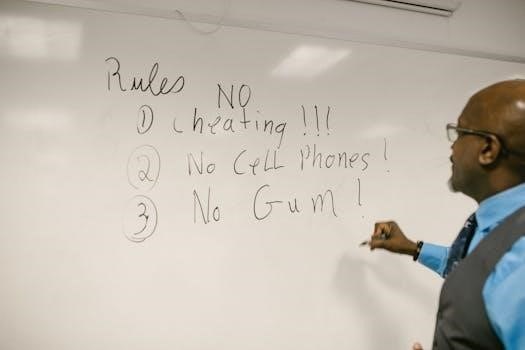Classroom Management⁚ A Focus on Harry Wong’s Principles
Effective classroom management‚ a cornerstone of successful teaching‚ finds profound guidance in the principles championed by Harry K. Wong. His emphasis on structured environments and clear procedures offers a roadmap for educators seeking to cultivate productive learning spaces.

Harry K. Wong‚ a revered figure in education‚ dedicated his life to empowering teachers with effective strategies. As an educator‚ speaker‚ and author‚ Wong’s impact resonates deeply within classrooms worldwide. His seminal work‚ “The First Days of School‚” has sold millions of copies‚ offering invaluable guidance on classroom management and instructional practices.
Wong’s approach emphasizes the importance of creating structured‚ organized learning environments where students feel safe‚ respected‚ and ready to learn. His teachings focus on establishing clear procedures‚ routines‚ and expectations from the very first day of school; This proactive approach minimizes disruptions‚ maximizes instructional time‚ and fosters a positive classroom climate.
Through his books‚ workshops‚ and online resources‚ Wong and his wife‚ Rosemary T. Wong‚ have touched the lives of countless educators. Their work continues to inspire teachers to create classrooms where students thrive academically and socially‚ leaving an enduring legacy on the field of education.
The Core Philosophy⁚ Effective Teaching and Classroom Management
At the heart of Harry K. Wong’s philosophy lies the understanding that effective teaching and robust classroom management are inextricably linked. He posits that a well-managed classroom is not merely about controlling student behavior‚ but rather about creating an environment conducive to learning and growth.
Wong emphasizes that effective teaching begins with clear expectations‚ well-defined procedures‚ and a proactive approach to addressing potential challenges. He advocates for teachers to structure their classrooms meticulously‚ establishing routines that minimize disruptions and maximize instructional time. This structured environment allows teachers to focus on delivering engaging and meaningful lessons‚ fostering student understanding and achievement.
Furthermore‚ Wong underscores the importance of building positive relationships with students. By creating a safe and supportive learning environment‚ teachers can cultivate a sense of belonging and encourage students to take risks and embrace challenges. This holistic approach to teaching and management fosters a classroom where students thrive academically‚ socially‚ and emotionally.

Essential Elements of Wong’s Classroom Management
Harry Wong’s classroom management hinges on key elements. These include establishing procedures and routines‚ creating a well-structured classroom‚ and building a positive learning environment where students feel safe and supported.
Establishing Procedures and Routines
At the heart of Harry Wong’s classroom management philosophy lies the establishment of clear procedures and routines. These are not mere rules‚ but carefully planned systems that guide student behavior and create a predictable learning environment. Effective procedures minimize disruptions and maximize instructional time‚ allowing teachers to focus on teaching and students to focus on learning.
Wong emphasizes teaching procedures explicitly‚ just as teachers teach academic content. This involves explaining the procedure‚ modeling it for students‚ providing opportunities for practice‚ and offering feedback. Consistency is key; by consistently enforcing procedures‚ teachers create a sense of order and fairness in the classroom.
Examples of essential procedures include entering the classroom‚ transitioning between activities‚ asking for help‚ and participating in group work. When students know what is expected of them in each situation‚ they are more likely to behave appropriately. Procedures contribute to a well-managed classroom where learning can thrive.
The Importance of a Well-Structured Classroom
Harry Wong underscores the critical role of a well-structured classroom in fostering student success. Structure‚ in this context‚ refers to the intentional organization of the physical environment‚ routines‚ and expectations to optimize learning. A well-structured classroom minimizes distractions and maximizes student engagement.
When the classroom environment is predictable and organized‚ students feel safe and secure‚ which allows them to focus on academics. Clear expectations reduce anxiety and confusion‚ empowering students to take ownership of their learning. Effective teachers carefully plan the layout of the classroom to facilitate movement‚ collaboration‚ and individual work.
Furthermore‚ a well-structured classroom promotes efficiency. Transitions between activities are smooth‚ materials are readily accessible‚ and students know where to find what they need. By creating a structured environment‚ teachers create a positive and productive learning space where all students can thrive. This proactive approach to classroom management is essential for effective teaching and student achievement.
Creating a Positive and Safe Learning Environment
Central to Harry Wong’s philosophy is the creation of a positive and safe learning environment. This involves establishing a classroom culture where students feel respected‚ valued‚ and supported. A positive environment fosters motivation and engagement‚ while a safe environment promotes risk-taking and vulnerability‚ essential for learning.
Teachers can cultivate a positive climate by building strong relationships with their students. Getting to know students’ interests‚ strengths‚ and challenges helps teachers tailor instruction and provide personalized support. Encouragement‚ praise‚ and positive feedback reinforce desired behaviors and build student confidence. Clear communication is also key. Teachers should clearly communicate expectations and provide opportunities for students to share their thoughts and feelings.
In a safe classroom‚ students feel comfortable asking questions‚ making mistakes‚ and expressing themselves. This requires establishing clear boundaries‚ addressing bullying and harassment promptly‚ and promoting empathy and respect. By prioritizing positivity and safety‚ teachers can create a learning environment where all students feel empowered to reach their full potential.

Practical Applications of Wong’s Methods
Wong’s methods translate into actionable strategies for educators. Developing comprehensive plans‚ implementing procedures from day one‚ and adapting to diverse grade levels ensures effective classroom management‚ fostering structure and student success.
Developing a Comprehensive Classroom Management Plan
Crafting a robust classroom management plan‚ as advocated by Harry Wong‚ is pivotal for establishing a structured and productive learning environment. This plan should serve as a detailed blueprint‚ outlining every facet of classroom operations from the first day until the school year’s conclusion. It encompasses clearly defined procedures‚ expectations‚ and consequences‚ ensuring students understand the framework within which they operate.
The plan should address various aspects of classroom life‚ including routines for entering and exiting the classroom‚ procedures for handling materials‚ and protocols for student interactions. It is paramount to incorporate proactive strategies to prevent disruptions‚ rather than solely relying on reactive measures. A well-developed plan also accounts for differentiated instruction and diverse student needs‚ fostering an inclusive and supportive atmosphere.
The Wongs emphasize that a comprehensive plan isn’t a rigid set of rules but a flexible guide‚ adaptable to the unique dynamics of each classroom. Its creation involves careful consideration of student demographics‚ learning objectives‚ and school-wide policies. Ultimately‚ the goal is to create a safe‚ positive‚ and conducive environment where students can thrive academically and socially.
Implementing Procedures on the First Day of School
The first day of school‚ as Harry Wong emphasizes‚ is crucial for setting the stage for effective classroom management. It is the prime opportunity to explicitly teach and model the established procedures‚ ensuring students understand expectations from the outset. The focus should be on clarity and consistency‚ avoiding ambiguity that can lead to confusion and misbehavior.
Begin by clearly communicating the most important procedures‚ such as entering the classroom‚ finding assigned seats‚ and participating in class discussions. Demonstrate each procedure step-by-step‚ allowing students to practice and receive immediate feedback. Reinforce positive behavior and correct mistakes gently‚ creating a supportive learning environment.
Wong advocates for actively engaging students in the process‚ encouraging questions and addressing concerns. The goal is not merely to enforce rules but to foster a sense of shared responsibility and understanding. By investing time on the first day to establish these routines‚ teachers can create a well-managed classroom where students feel safe‚ respected‚ and ready to learn throughout the year. Remember‚ a strong start paves the way for continued success.
Adapting Wong’s Strategies for Different Grade Levels
Harry Wong’s classroom management strategies‚ while universally applicable‚ require thoughtful adaptation to suit the developmental needs of different grade levels. Elementary students‚ for instance‚ may benefit from visual aids‚ simplified instructions‚ and frequent positive reinforcement to grasp and adhere to classroom procedures. Older students‚ on the other hand‚ may respond better to more autonomy and opportunities for self-regulation.
In middle school and high school settings‚ teachers can foster a sense of ownership by involving students in the creation of classroom rules and procedures. This collaborative approach encourages buy-in and promotes responsible behavior. Furthermore‚ adapting Wong’s strategies may involve incorporating technology to enhance engagement and streamline classroom routines.
Regardless of the grade level‚ the core principles of clear expectations‚ consistent enforcement‚ and a positive learning environment remain paramount. The key is to tailor the implementation of Wong’s methods to resonate with the specific characteristics and needs of the students‚ ensuring that the strategies are both effective and age-appropriate. By thoughtfully adapting these approaches‚ educators can create well-managed classrooms that support learning across all grade levels.

Resources and Further Learning
To delve deeper into Harry Wong’s effective teaching methodologies‚ a wealth of resources awaits educators. From his website to publications and training‚ opportunities abound to enhance classroom management skills and create engaging learning environments.
HarryWong.com⁚ A Hub for Effective Teaching Resources
HarryWong.com stands as the digital embodiment of Harry and Rosemary Wong’s lifelong dedication to effective teaching. This website serves as a comprehensive hub‚ offering a treasure trove of resources designed to empower educators at all levels. It encapsulates their award-winning classroom experience‚ distilled into practical advice and actionable strategies.
Here‚ teachers can discover a variety of media‚ including articles‚ videos‚ and interactive courses‚ all focused on enhancing classroom management and instructional techniques. The site showcases examples of what effective teachers do to manage their classrooms‚ providing a roadmap for creating a safe and positive learning environment.
Furthermore‚ HarryWong.com provides access to free resources and products‚ all geared towards improving teaching effectiveness‚ management skills‚ and teacher expectations. Whether you’re a new teacher seeking guidance or an experienced educator looking to refine your approach‚ this website offers invaluable support and inspiration. It is a testament to their enduring commitment to helping teachers succeed.
Books and Publications by Harry and Rosemary Wong
Harry and Rosemary Wong have significantly impacted the field of education through their extensive collection of books and publications. Their cornerstone work‚ “The First Days of School⁚ How to Be an Effective Teacher‚” has sold over 3.5 million copies‚ solidifying its place as an essential guide for educators. This book‚ now in its fifth edition‚ offers practical advice on improving academic instruction and classroom management.
Beyond this seminal text‚ the Wongs have created a variety of resources in CD-Audio and DVD formats‚ catering to diverse learning preferences. Their publications provide solutions for establishing classroom management from the ground up‚ applicable across all grade levels and subject areas.
These books are designed to help teachers organize and structure their classrooms‚ fostering a safe and positive environment conducive to student learning and achievement. With a focus on actionable strategies and real-world examples‚ Harry and Rosemary Wong’s publications serve as invaluable tools for educators seeking to enhance their effectiveness and create thriving learning communities.
Training and Professional Development Opportunities
To further disseminate their effective teaching methods‚ Harry and Rosemary Wong have developed various training and professional development opportunities for educators. These programs aim to equip teachers with the knowledge and skills necessary to implement their classroom management strategies successfully.
These training sessions often delve into the core principles of the Wong’s approach‚ emphasizing the importance of well-defined procedures‚ structured classroom environments‚ and positive teacher expectations. Participants learn how to develop comprehensive classroom management plans‚ implement procedures on the first day of school‚ and adapt Wong’s strategies to different grade levels and student populations.
These opportunities may include workshops‚ seminars‚ and online courses‚ providing flexible options for teachers to engage with the material. By participating in these training programs‚ educators can gain practical insights‚ refine their classroom management skills‚ and create more effective and engaging learning experiences for their students. These courses are filled with examples of what effective teachers do to manage their classrooms.
